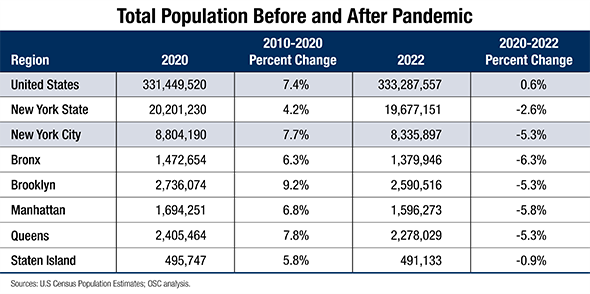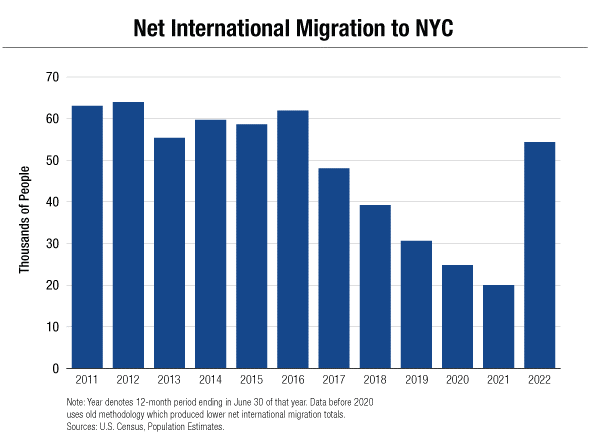Population shifts during and after the COVID-19 pandemic are changing the face of New York City and highlight significant policy implications moving forward, according to a report released today by New York State Comptroller Thomas P. DiNapoli.
“Ongoing changes to the city’s makeup have important implications for the budget and policy decisions we are making today,” DiNapoli said. “In the pandemic’s wake, we see an altered population and it raises longstanding concerns about the cost of living, the growing wealth gap, the need to preserve a strong middle class, and the challenges of serving an aging population, while ensuring that families are able to raise their children here. We need the city to remain competitive on the world stage and a place where people want to move, put down roots and thrive.”
Pandemic Wipes Out Years of Population Growth
In the decade before the pandemic, from 2010 to 2020, the city’s population grew 7.7%, outpacing the nation’s 7.4% growth, even as many continued to leave. The 629,057 new New Yorkers in that decade was greater than Miami’s total population of 442,241 in 2020. Brooklyn and Queens led the way with 9.2% and 7.8% growth respectively, with the population in all five boroughs increasing overall more than it did in the previous decade.
Virtually all of the population growth (99%) was natural increase — more births than deaths — and it was slowing year by year as 2020 approached. Despite the overall net population increase, people were also leaving the city, largely for other parts of New York and New Jersey. Looking just at domestic migration within the United States, including to elsewhere in New York State, one million more people left the city than moved to it, which mostly offset any gains from international migration to the city.
When the pandemic hit, it wiped out nearly three-quarters of the decade’s population gains. The city’s population shrank by 5.3% from 2020 to 2022. The number of people leaving the city for other parts of the state or the country spiked in 2021, with a net loss of 313,358 people.
Decline and Rebound of International Immigration
More than 1-in-3 New Yorkers (36.7%) is foreign born. These immigrants comprise the majority of the population in Flushing, Jackson Heights and other city neighborhoods. From 2017 through 2021, international migration into the city fell sharply due to restrictive federal policies and pandemic travel restrictions, just as it did nationally. In 2022, however, as the pandemic subsided, net international migration to the city was more than double the previous year with 54,307 new New Yorkers, the most since 2016.
Post-Pandemic Change in Resident Population
In the wake of the pandemic, the city’s populace is overall older and wealthier, with a rebounding population of international migrants and declining shares of White and Black New Yorkers.
From 2019 to 2021, the percentage of households in the city earning over $100,000 fell for the first time in more than a decade to 35.2%. That statistic rebounded to a record high of 39% in 2022, however, as the pandemic waned. In addition, the median wage of those who moved into the city that year was $51,000, which was 13.3% more than in 2021.
The cost of living also rose as the pandemic subsided, making the city increasingly more expensive for lower income New Yorkers, who left in greater numbers in 2022. The median wage of those who left the city in 2022 was $49,000, which was 18% less than those who left in 2021.
Among those who left the city in 2022, 64% were non-White, which was higher than the 58% in 2021 and the 62% in 2019 and 2018. From April 2020 to June 2022, the population of all major racial and ethnic groups declined after a decade of increases, but did so at varying rates. White and Black populations in the city fell 6.7% and 6.0% respectively — greater than the overall population decline — while the declines in Hispanic (5%) and Asian (2.5%) New Yorkers were smaller.
The city’s senior population was the only group analyzed that increased from April 2020 to June 2022, growing by 3.3%. At the same time the population under 18 fell by 7.5%, much faster than the national decline of 1.5%. Children made up 20.1% of the city’s population in 2022 compared to 20.6% in 2020.
Report
NYC's Shifting Population: The Latest Statistics
Other related work
New York City's Uneven Recovery: An Analysis of Labor Force Trends


